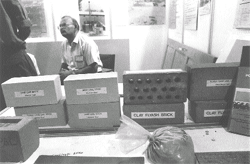Made to order
 government plans have laid a lot of emphasis on research and development of appropriate technologies for rural areas since the First Five-Year Plan. But one shortcoming in making these technologies widely available and acceptable has been the lack of dissemination and communication of the work carried out by several research agencies, both governmental and non-governmental, in this area. The National Research and Development Corporation ( nrdc ), a Union government enterprise under the department of science and industrial research, has established links with a number of technology-generating agencies. These include research and development organisations in the public sector such as the Council for Scientific and Industrial Research and the Indian Council of Agricultural Research. ndrc also engages itself in the development of technology from the bench-scale to pilot plant or prototype stage through a funding mechanism specially designed by it in association with the industry ( w i sta Rural Technology , Vol 5, No 8).
government plans have laid a lot of emphasis on research and development of appropriate technologies for rural areas since the First Five-Year Plan. But one shortcoming in making these technologies widely available and acceptable has been the lack of dissemination and communication of the work carried out by several research agencies, both governmental and non-governmental, in this area. The National Research and Development Corporation ( nrdc ), a Union government enterprise under the department of science and industrial research, has established links with a number of technology-generating agencies. These include research and development organisations in the public sector such as the Council for Scientific and Industrial Research and the Indian Council of Agricultural Research. ndrc also engages itself in the development of technology from the bench-scale to pilot plant or prototype stage through a funding mechanism specially designed by it in association with the industry ( w i sta Rural Technology , Vol 5, No 8).
There are quite a few industrial technologies relevant to rural areas that are considered to have good potential for commercial use. They are simple and can be adopted using raw materials that are easily available in rural areas. In the field of construction material, the technologies include an energy-efficient brick-making machine, a cement-coconut shell pithy concrete that is comparable to conventional insulating materials and a technology to make bricks from flyash. The brick-making machine is a plant for automatic shaping and moulding of bricks. This replaces pug mills that are now considered outdated. The machine can produce 3,000 wirecut bricks per hour with a low rate of power consumption. The plant's production capacity is 9 million bricks per annum. The capital investment needed is Rs 20 lakh and the cost of production of each machine is Rs 5 lakh.
Another invention is a brick-making plant that relies on flyash (obtained from thermal power stations) to partly substitute use of sand in bricks. The bricks thus produced have a uniform and smooth surface that results in a 30 per cent saving in mortar and plastering. The bricks can be used within 24 hours of their manufacture. The capital investment for a plant manufacturing 3,000 bricks per hour, working in three shifts for 300 working days a year, is estimated at Rs 140 lakh. A thermal insulating material called cement-coconut shell pith concrete is another discovery. This is based on coconut pith, which is available abundantly. Cement-coconut pith concrete is much lighter and gives better thermal insulation for equal cost.
Also on offer is a technology that utilises groundnut shells for producing microcrystalline cellulose ( mcc ), which is widely used in the food industry as a filler material and in the pharmaceutical industry as an excipient (an inactive substance that serves as the vehicle or medium of a drug) of tablets, capsules and other forms of drugs. Cellulose is generally obtained from various sources like bamboo, sugarcane bagasse, paper waste and cotton waste. nrdc uses groundnut shell, a waste material that is easily available throughout the country. Another technology that utilises waste involves production of pectin, an emulsifying agent widely used in the preparation of pharmaceutical and cosmetic products, from sunflower seed shells. Pectin also finds application in the treatment of diarrhoea, and has been found very useful in reducing blood cholesterol and blood glucose levels. Sunflower seed shell, a waste material, has been found to be a good source of pectin. Studies have shown that 180 kg of pectin can be produced using seed shells from a one-hectare sunflower field.
Those interested in further details can write to: Waterfalls Institute of Technology Transfer, J-29, South Extension Part 1, New Delhi 110049
Related Content
- Order of the National Green Tribunal in the matter of Futala lake pollution, Nagpur, Maharashtra, 05/06/2025
- Order of the National Green Tribunal regarding large scale felling of toddy yielding palm trees in Bihar, 05/06/2025
- Order of the National Green Tribunal regarding violation of environmental norms by a tyre pyrolysis plant, village Sakauti, Shamli, Uttar Pradesh, 28/05/2025
- Judgment of the Supreme Court regarding status of Zudpi lands in Maharashtra, 22/05/2025
- Order of the National Green Tribunal regarding discharge of wastewater by the municipality of Belpahar on a farmers land, Jharsuguda, Odisha, 15/05/2025
- Order of the National Green Tribunal regarding a dumping ground located at Debendra Chandra Nagar run by the Agartala Municipal Corporation, Tripura, 15/05/2025
